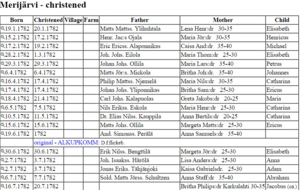
The HisKi database (Historiakirjat) is an online service provided by the Genealogical Society of Finland, designed as a tool for researching parish records, such as lists of baptisms, marriages, and burials. HisKi serves as a supplementary research tool, but it does not replace the examination of original parish records in genealogical research.[1]
Research your ancestors on MyHeritage
History of the HisKi projectHistory of the HisKi project
The development of the HisKi database began in the 1990s, making it Finland's longest-running continuous online service. Initially, the database was based on handwritten copies of parish records, known as "black books," commissioned by the Genealogical Society of Finland in the 1920s to 1940s. Today, the database is updated directly from digitized original church records through a separate data entry platform.
Features of the HisKi projectFeatures of the HisKi project
The information in HisKi often results from a three-step copying process, which has introduced errors. These errors may stem from mistakes made by the clergy in the original entries, inaccuracies in the copying of the black books, or errors made during the data entry phase. Therefore, HisKi should be used critically and only as a research aid, and all information should be verified against original sources. HisKi is most effective in providing a quick overview of a family's structure, helping to trace the occurrence of specific family or farm names across different regions of Finland, and facilitating the tracking of individuals who may have gone missing in neighboring parishes.
How to use the HisKi portalHow to use the HisKi portal

The HisKi homepage features a list of parishes alongside a map of Finland divided into provinces. You can select a specific parish, all parishes in the database, or multiple parishes simultaneously by holding down the Ctrl key and clicking on the parish names. Parishes can also be selected regionally by clicking on the map or choosing a province from the drop-down menu below the map.
After selecting the parishes, click the "Selected" button to access the book catalog. From there, you can choose the specific book from which you want to retrieve information. If only one parish is selected, only the books containing data will be displayed. Each book entry includes the time range for which information is available in the database. In addition to baptism, marriage, and burial records, HisKi also contains lists of people who have moved and statistical data, which can be found in the book catalog.
In old church records, the spelling of names often varies, meaning that both personal and place names can appear in multiple forms. This is important to consider when using HisKi. First names in HisKi have largely been standardized, so basic names such as Heikki and Henrik should theoretically also retrieve variants like Henr., Henric, Henricus, and Hindirch, among others. However, it is still recommended to conduct searches using different variations, as the normalization of family and place names in HisKi is incomplete. For instance, searching for the name Wikström might miss cases where the name is spelled Wijkström. Both in Swedish and Finnish, name spellings were inconsistent in different sources for a long time.
Search criteria should be limited only as much as necessary. The fewer restrictions applied to a search, the more comprehensive the results will be, reducing the risk of missing relevant information. For example, using an exact patronymic for parents may exclude some children from the search results simply because, in the original baptism record, only the mother's first name was recorded. Similarly, last names were not consistently used in the original sources, so a person may be listed under a patronymic in some records and a surname in others.
It is essential for HisKi users to remember that the database is not comprehensive. It does not include all Finnish parishes, and even for those it does cover, there are significant gaps in almost all regions. The initial phase of the data entry project aimed to gather information up to 1850 for the entire country. Later, additional data was added, and for some parishes, information extends into the early 20th century. However, for many parishes, the data has been entered only partially. This naturally affects the scope and interpretation of search results.
HisKi should always be seen as a supplementary tool, and in any case of doubt, original documents such as baptism, marriage, and burial records should be consulted. There are some interpretative errors in HisKi, especially regarding individuals' occupations and causes of death.
Multilingual availability of HisKiMultilingual availability of HisKi
The complete search instructions in English can be found here.
See alsoSee also
Explore more about the HisKi projectExplore more about the HisKi project
- Research Finns – Finnish not required; Internet is! webinar at Legacy Family Tree Webinars
- HisKi project. Genealogical Society of Finland

